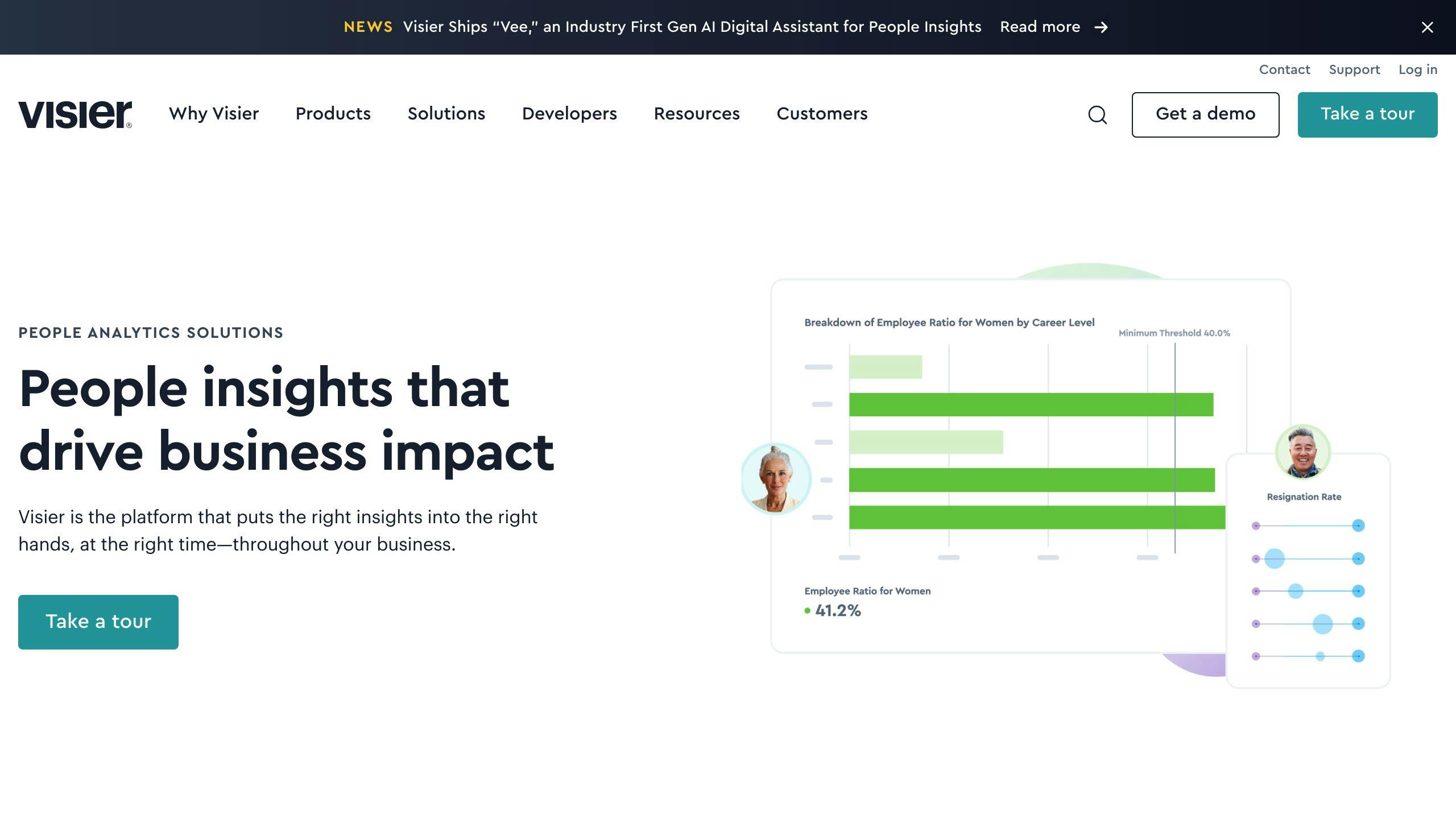Unlocking the power of HR analytics while protecting employee privacy is a delicate balance. Here are the key points:
-
The Benefits of HR Analytics
- Data-driven decision-making
- Identifying high-potential candidates
- Developing personalized training programs
- Predicting employee turnover and burnout
-
Privacy Risks and Consequences
- Data breaches leading to legal issues and reputational damage
- Misuse of analytics perpetuating biases and discrimination
- Unauthorized access to sensitive employee information
-
Strategies for Balancing HR Analytics and Privacy
| Strategy | Description |
|---|---|
| Data Minimization | Collect only necessary employee data |
| Transparency | Clearly communicate data usage and benefits to build trust |
| Secure Data Storage | Implement robust security measures like encryption and access controls |
| Obtain Consent | Get explicit consent from employees before data collection |
| Comply with Regulations | Appoint data protection officers and conduct regular audits |
By prioritizing transparency, data security, and ethical data use, organizations can harness the benefits of HR analytics while safeguarding employee privacy and fostering a culture of trust.
The Conflict: Data-Driven HR vs. Privacy
Why HR Analytics Matter
HR analytics has transformed the way organizations manage their workforce. By using HR analytics, organizations can:
- Identify areas for improvement
- Optimize processes
- Make informed decisions about talent management
- Develop personalized training programs
- Predict employee turnover
- Improve operational efficiency
- Reduce costs
- Enhance overall business performance
Privacy Risks in HR Data Use
However, the increased reliance on HR analytics raises concerns about employee data privacy. The collection and analysis of vast amounts of employee data can lead to:
| Privacy Risks | Consequences |
|---|---|
| Data breaches | Legal repercussions, reputational damage, erosion of employee trust |
| Misuse of HR analytics | Perpetuation of biases and discrimination, unfair treatment of employees |
| Unauthorized access | Compromise of sensitive employee information, such as salaries, health records, or performance evaluations |
To strike a balance between the benefits of HR analytics and the imperative to safeguard employee privacy, organizations must prioritize transparency, data security, and ethical data use. By doing so, organizations can ensure that HR analytics is used to drive business outcomes while protecting the rights and interests of employees.
Root Causes of the HR Analytics Privacy Clash
The tension between HR analytics and employee data privacy arises from several key factors. Understanding these root causes is crucial for finding a balance between the benefits of HR analytics and the imperative to safeguard employee privacy.
Transparency and Data Management Impact
One primary cause of the HR analytics privacy clash is the lack of transparency in data handling and poor communication with employees. When employees are not informed about how their data is being collected, used, and protected, they may feel uneasy or mistrustful of their employer. This lack of transparency can lead to privacy concerns, as employees may worry that their personal data is being misused or shared without their consent.
Poor data management practices can also exacerbate privacy concerns. If employee data is not properly secured, it can be vulnerable to breaches or unauthorized access. This can result in legal repercussions, reputational damage, and erosion of employee trust.
Navigating Data Protection Laws
Another significant factor contributing to the HR analytics privacy clash is the complexity of data protection laws. Regional laws, such as the General Data Protection Regulation (GDPR) and the California Consumer Privacy Act (CCPA), impose strict regulations on the collection, use, and protection of employee data.
| Data Protection Laws | Key Requirements |
|---|---|
| General Data Protection Regulation (GDPR) | Obtain explicit consent from employees, ensure fair and transparent data processing, and implement robust data protection measures |
| California Consumer Privacy Act (CCPA) | Provide employees with the right to access, delete, and opt-out of data collection, and ensure data protection measures are in place |
However, navigating these laws can be challenging, especially for organizations operating in multiple regions. The lack of clarity and consistency in data protection regulations can lead to confusion and uncertainty, making it difficult for organizations to ensure compliance.
By understanding the root causes of the HR analytics privacy clash, organizations can take steps to address these issues and find a balance between the benefits of HR analytics and the imperative to safeguard employee privacy.
Strategies for Data Privacy in HR Analytics
To ensure responsible use of HR analytics, organizations must implement strategies that prioritize employee data privacy. This section explores key solutions for strengthening data protection procedures within HR analytics.
Securing HR Data
Implementing robust security measures is crucial for protecting HR data. This includes:
| Security Measure | Description |
|---|---|
| Data encryption | Encrypting data both in transit and at rest adds an extra layer of protection against unauthorized access. |
| Access controls | Limiting access to sensitive HR data based on job roles and responsibilities helps minimize the risk of unauthorized access. |
| Anonymization | Anonymizing data during analysis contributes to privacy protection, especially when conducting workforce analytics. |
By securing HR data, organizations can reduce the risk of data breaches and protect employee privacy.
Building Transparency and Getting Consent
Transparency is key to building trust with employees. Organizations must:
1. Inform employees: Clearly communicate how their data will be used, stored, and protected. 2. Obtain consent: Obtain explicit consent from employees before collecting and processing their data. 3. Provide opt-out options: Allow employees to opt-out of data collection and processing if they choose to do so.
By building transparency and obtaining consent, organizations can ensure that employees are aware of and comfortable with how their data is being used.
Complying with Data Protection Laws
Staying updated with and complying with data protection regulations is essential. This includes:
| Compliance Step | Description |
|---|---|
| Appointing a data protection officer | Designating a data protection officer to oversee compliance with data protection laws. |
| Conducting regular audits | Regularly auditing data protection practices to ensure compliance with regulations. |
| Staying informed | Staying informed about changes to data protection laws and regulations. |
By complying with data protection laws, organizations can avoid legal repercussions and reputational damage.
By implementing these strategies, organizations can ensure that HR analytics is performed in a responsible and ethical manner that prioritizes employee data privacy.
sbb-itb-d78b90b
Best Practices for Ethical HR Analytics
To ensure responsible use of HR analytics, organizations should follow best practices that prioritize employee privacy and build trust.
Minimizing Data Collection
Collecting only necessary data reduces the risk of data breaches and protects employee privacy. This approach aligns with the principle of data minimization.
Building Trust Through Transparency
When employees understand how their data is used and see the benefits of HR analytics, they are more likely to trust the organization. This trust leads to increased employee satisfaction, productivity, and retention.
Staying Up-to-Date with Policy Evolution
Continuous learning and policy review are crucial to ensure compliance with evolving legal landscapes and technological advancements. This enables HR professionals to stay updated on best practices and emerging trends.
Key Takeaways
| Best Practice | Description |
|---|---|
| Data minimization | Collect only necessary data to reduce privacy risks. |
| Transparency | Inform employees about data use and benefits to build trust. |
| Continuous learning | Stay updated on best practices, regulatory changes, and emerging trends. |
By following these best practices, organizations can establish ethical HR analytics frameworks that prioritize employee privacy, build trust, and drive business success.
Real Examples of Privacy-Focused HR Analytics
Explore how companies like Visier and platforms such as LinkedIn successfully implement privacy-respecting HR analytics.
Visier: Balancing Data and Privacy

Visier handles data anonymization and k-anonymity standards to balance insightful analytics with stringent privacy control. This approach ensures that HR analytics are conducted in a way that respects employee privacy while still providing valuable insights for business decision-making.
| Visier's Approach | Description |
|---|---|
| Data Anonymization | Encrypting data to protect sensitive employee information |
| k-Anonymity Standards | Ensuring data is anonymous and cannot be linked to individual employees |
LinkedIn: Secure HR Analytics Guidelines

LinkedIn provides comprehensive guidelines for data minimization, employee consent, and secure analytics practices. This approach emphasizes the importance of transparency and employee trust in HR analytics.
| LinkedIn's Guidelines | Description |
|---|---|
| Data Minimization | Collecting only necessary data to reduce privacy risks |
| Employee Consent | Obtaining explicit consent from employees before collecting and processing their data |
| Secure Analytics Practices | Implementing robust security measures to protect HR data |
These real-world examples demonstrate that it is possible to balance the benefits of HR analytics with the need to protect employee privacy. By prioritizing privacy and transparency, organizations can build trust with their employees and ensure that HR analytics are conducted in an ethical and responsible manner.
Conclusion: Finding the Right Balance
Key Strategies and Practices Summary
To balance HR analytics with employee data privacy, organizations must prioritize transparency, consent, and security. Here's a summary of key strategies and practices:
| Strategy | Description |
|---|---|
| Define a clear purpose | Clearly communicate the purpose of data collection to employees |
| Ensure data minimization | Collect only necessary data to reduce privacy risks |
| Obtain explicit consent | Get explicit consent from employees before collecting and processing their data |
| Establish secure data storage | Implement robust security measures to protect HR data |
| Limit access to data | Limit access to data on a need-to-know basis |
| Stay up to date with regulations | Stay informed about changing data privacy regulations |
Looking Ahead: HR Analytics and Privacy
As HR analytics continues to evolve, organizations must stay ahead of the curve and prepare for future challenges. This includes:
- Preparing for the increasing importance of artificial intelligence and machine learning in HR analytics
- Adapting to more stringent data protection regulations
- Prioritizing continuous learning and policy evolution to ensure ethical and responsible HR analytics practices
By following these strategies and staying ahead of the curve, organizations can build trust with their employees, protect sensitive data, and unlock the full potential of HR analytics to drive business success.
FAQs
What are the ethics of HR analytics balancing data collection with employee privacy?
The ethics of HR analytics involve finding a balance between collecting data and protecting employee privacy. Organizations must:
- Obtain explicit consent from employees before collecting and using their personal data
- Ensure data is protected from unauthorized access or misuse
- Mitigate biases and discrimination through responsible data practices
By prioritizing transparency, consent, and security, organizations can build trust with their employees and unlock the full potential of HR analytics to drive business success.
Why is it essential to balance HR analytics with employee data privacy?
Balancing HR analytics with employee data privacy is crucial because:
| Reason | Description |
|---|---|
| Builds trust | Employees are more likely to trust organizations that prioritize their privacy |
| Reduces risks | Protects organizations from legal repercussions and reputational damage |
| Ensures responsible use | Prevents misuse of HR analytics and perpetuation of biases and discrimination |
By balancing HR analytics with employee data privacy, organizations can create a positive and productive work environment while driving business success.


